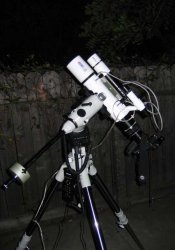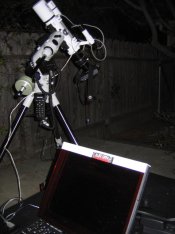Hi Sparky!
No joke about the camera, here's a link:
Dead Link Removed
However, it appears it is no longer sold. Might be able to find one used or contact them for a one-time job. That's too bad since I was thinking of getting one.
Ok, great to hear that you're interested in starting astrophotography! Be ready for a money and time vortex! It is such a rewarding hobby for sure.
Are you planning on using film? If you're going to mount just a camera and lens, you won't get any decent close-up shots of nebulae. I think you'd need at least something like a 400mm lens to do that and often at that scale you'll need to expose for a while which means you'll need a guidescope as well to counteract the earth's rotation which gives the stars their apparent movement across the sky. And honestly a lot of camera lenses are pretty....bad....for astrophotography since they will often have distortions at their edges that you won't notice in a terrestrial shot but will notice when you have a large field of pin-point stars.
Even if you're using a 100mm lens you'd need to have a polar alignment with the north celestial pole. The most accurate way is to do a drift alignment which means you'll need a scope. At 100mm you might be able to get 5-10 minutes at best before your stars would streak across the film. With film astrophotography the camera doesn't matter as much (you do NOT want one with a light meter!). As long as it is totally manual you can take great shots.
As for the Losmandy GM-8...I used to think I needed an expensive mount to do astrophotography, until I looked at work done by Peter Kennett and Chris Provost. Both of them use Meade LXD75 mounts which can be had for as little as $500 used with GO-TO. Peter uses a large scope on the mount, but Chris has recently started using a relatively small scope. Here's a link to shots taken by Peter:
http://www.petesastrophotography.com/index.html?mainframe=/galleryindex.html
and here's a link to Chris' first shot with a small scope on the LXD 75:
Dead Link Removed
Both Peter and Chris use old Olympus OM-1s. This is one hobby where the more expensive cameras take a back seat ;-) If you are serious about buying a dedicated film astrocamera, look here:
http://www.sciencecenter.net/hutech/mitsub/index.htm
Peter manually guides his shots and Chris uses an autoguider. I believe that with a Meade LXD75 and a small scope using a DSI Pro autoguider you can do very long exposures. No need for a Gm-8, in my opinion. I went with Borg scopes for mine - they are the lightest telescopes out there and of are very high quality (often compared to TeleVue and Takahashi). I have gone as long as 45 minutes with my scope/mount combo. You can find more info on Borg scopes at
http://www.sciencecenter.net/hutech/index.htm and
http://www.sciencecenter.net/hutech/borg/index.htm
You'll also need to consider filters for light pollution, etc. I can go into that if you'd like, but I think I've typed waaay too much for only have like 2 posts at the board!
I've attached a picture of my setup getting ready to shoot the Leo Triplet of galaxies (35 million light years away). The best films for astrophotography are Elite Chrome 200 and Fuji Provia 400F. Provia is better for galaxies and Elite Chrome is better for nebulae.
If you do have any other questions please feel free to ask. There are a couple of sites on the net where film astrophotography is alive and well - groups like this full of great people willing to share. I can send them to you or post them here if you'd like.
By the way, Lumicon told me a few months ago that they no longer sell hypered Tech Pan and also for shooting the sun/moon as I had originally mentioned shutter vibrations make a huge difference. Luckily my camera (Pentax K1000) has mirror-lockup.
Cameran













 Donald my very old Tasco wobbles for that long each time I adjust the focus. Hence my search for a new telescope to attach a camera to. Apparently there are as many opinions about which is the best set-up as there are about film/dev combinations.
Donald my very old Tasco wobbles for that long each time I adjust the focus. Hence my search for a new telescope to attach a camera to. Apparently there are as many opinions about which is the best set-up as there are about film/dev combinations.